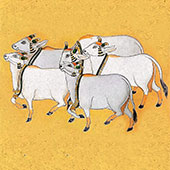Colonial-era paintings in India emerged during the British Raj (1858- 1947 CE) and were heavily influenced by European art styles, such as Realism and Impressionism. These paintings often depicted landscapes, portraits, and scenes from daily life in India, but with a more Western perspective. The artists of the colonial era were interested in capturing the unique aspects of Indian culture and landscape, but often did so through the lens of colonialism and Orientalism, resulting in a romanticized view of India that was appealing to Western audiences. The subjects in these paintings were varied and often depicted the day to day life of the nobility, street scenes, river banks, people going to the temples, people whom the British met in the marketplace and in the cities and villages and so on, apart from natural landscapes.
Depiction for current events
The illustrations in newspapers and other publications were an important means of raising awareness about the impact of famine in colonial India. These illustrations were often included in newspapers, pamphlets, and other forms of media, and they were intended to convey the severity of the crisis to a wider audience.
The purpose of these illustrations was to generate public sympathy and support for relief efforts. By depicting scenes of suffering and deprivation, the illustrations aimed to elicit an emotional response from readers and to encourage them to take action to help those affected by the famine. In addition to their immediate impact on public opinion, these illustrations also played an important role in shaping historical memory of the famines in colonial India. They helped to document the scale and severity of the crisis, and they served as a reminder of the human cost of British colonial policies.

Engraving from personal copy of The Graphic, 6 October 1877, entitled “The last of the herd,” about the plight of animals as well as humans in the Bellary district of the Madras Presidency, British India during the Great Famine of 1876–78.
(Image source)
Cattle in Rural India
The depiction of cattle in rural contexts in colonial India can be seen in various forms of media, including paintings, photographs, and literature. Cattle played a significant role in rural life in colonial India, and their depiction in art and literature provides insight into the social, cultural, and economic significance of these animals.
In many paintings and photographs from colonial India, cattle are depicted as an integral part of rural life. They are often shown grazing in fields or being used for ploughing, transportation, or milk production. These depictions highlight the close relationship between humans and animals in rural India and the importance of cattle to the rural economy.
In literature, cattle are often depicted in pastoral scenes or as a symbol of traditional rural life. The poetry of Rabindranath Tagore, for example, frequently references cattle as a symbol of rural life and the natural world. In his poem “The Gardener”, Tagore describes a cow grazing in a field, capturing the peaceful and harmonious relationship between humans, animals, and nature in rural India.
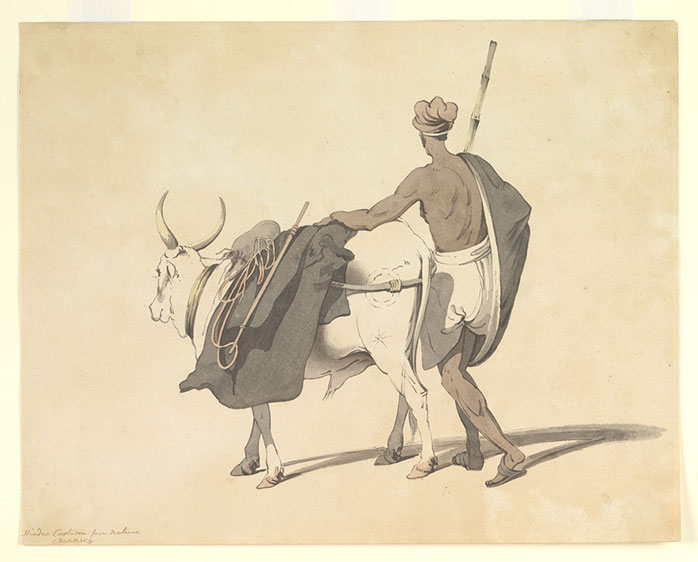
“Indian villager with bullock,” pen and ink on paper, by the Anglo-Indian artist George Chinnery. Dated between 1808 and 1822. Courtesy of the British Library, London.
(Image source)
(Image source)
(Image source - right)
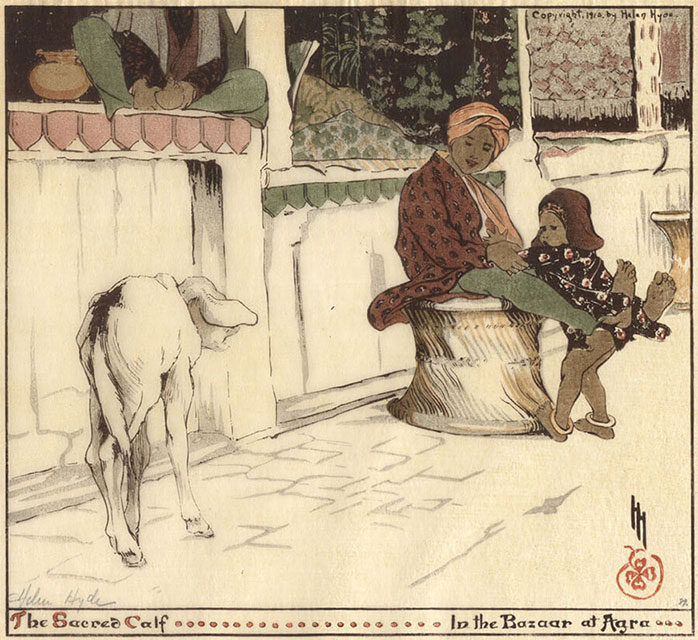
“The Sacred Calf in the Bazaar at Agra” Helen Hyde, American (1868-1919) The Sacred Calf in the Bazaar at Agra, color woodcut, 1910. Mason and Mason
(Image source)
Symbol of Hinduism
The iconography of this print emerges in conjunction with the popularization of lithographic images of the Hindu gods; it has no real historical precedent. According to Pinney, such images seem to be related to the growing importance of cow protection groups who were attempting to “rouse Hindu feelings against Christians and Muhammadans on account of the killing of cows”. The cow comes to embody Hindu cosmology; technically 84 gods are shown within the cow’s body, though in this example only 33 appear. This imagery played an important role in the emergence of Hindu nationalism that targeted meat-eating lower casts along with non-Hindu religious and colonial communities. Variations on this iconography were issued by most of the major presses.
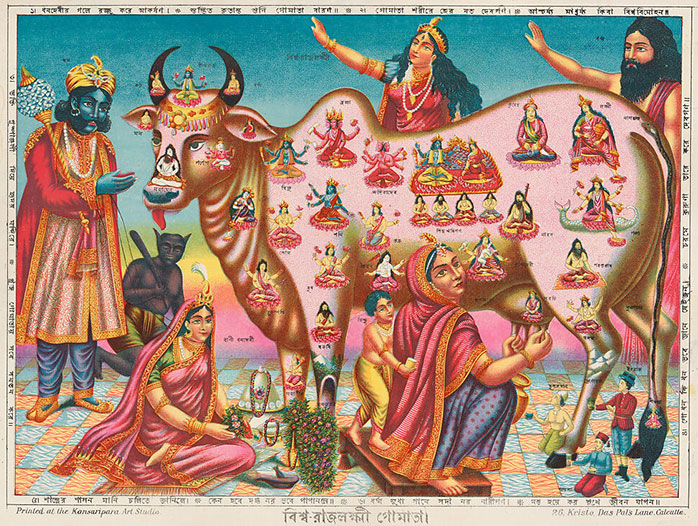
Vishva Rajalakshmi Gomata India ca. 1890
(Image source)
Depiction by famous painters of the period
Analyzing paintings of famous painters of the colonial era that depict cattle in India is important because they provide valuable insight into the cultural and social significance of cattle in India during that time period. These paintings can help us understand the attitudes and beliefs of colonial artists towards Indian culture, as well as the role of cattle in Indian society at that time.
Abanindranath’s painting of a bull highlights the story-telling aspect of the artist’s imagination. Abanindranath’s place as a master storyteller of Bengali children’s literature is well established. He endows his animals with almost human feelings and emotions. The solitary animal in the image is homesick for his distant mountain home. It has reference to the mythological account of the bull being the vehicle of Shiva whose abode is Mount Kailash. The palette indicates that the painting may have been done between 1915 and 1920. The inscription mentions, signed ‘Abanindra’ in Devanagari script at bottom right corner of the painting with a brush.
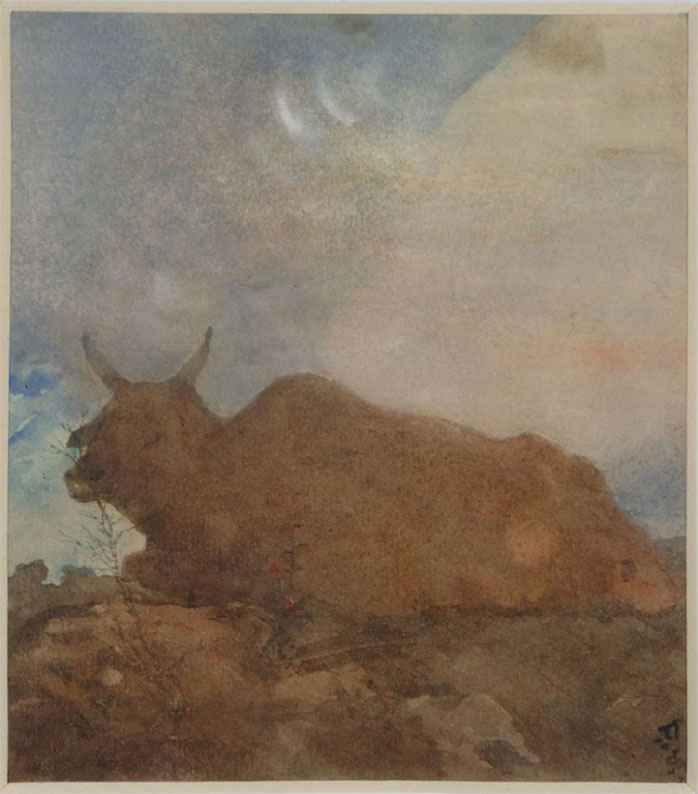
Dreaming of Kailash by Abanindranath Tagore National Gallery Of Modern Art, New Delhi
(Image source)
Towards the close of the 19th Century, Abanindranath Tagore challenged the British academic system of art education and the physicality of the oil medium. As the 20th century dawned, Abanindranath sought to subvert the academic realist art practices of the time and project new aesthetics in visual language. This led him to found a new art school popularly known as Bengal School. He was greatly inspired by the Mughal miniature traditions and the Japanese wash technique.
‘Journey’s End’, one of the masterpieces of Abanindranath, is expressive of Abanindranath’s visual language. It shows a camel that has collapsed under its heavy load carried over long distances. The image shows Abanindranath’s precise yet delicate lines, intensity of the emotive content, a combination of glowing colours and a misty appearance. These qualities make ‘Journey’s End’, an unforgettable image.
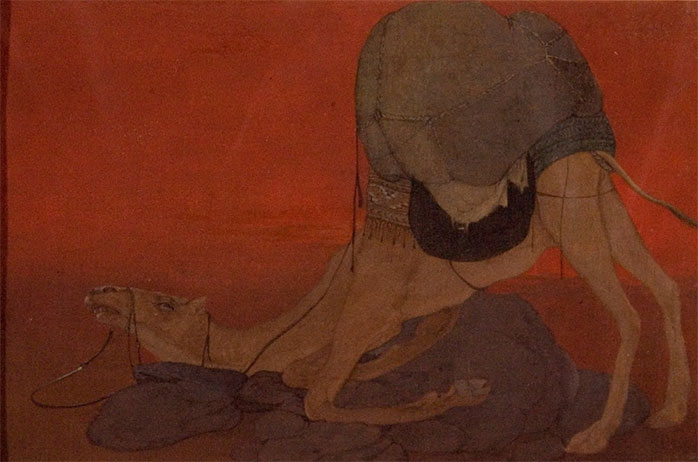
Journey’s End by Abanindranath Tagorecirca 1913 National Gallery Of Modern Art, New Delhi
(Image source)
Haripura posters by Nandalal capture moments of everyday Indian village life and culture. This poster is one of many examples of acute observation of his surroundings in which he has depicted a farmer engaged in the act of ‘ploughing the field’. The illustration has been articulated with an earthen colour palette and swift strokes executed the contours in a calligraphic manner that both the styles and subject matter exude the charm and playfulness often found in folk art. This aptly links the figure with the artist’s personal sensibilities. The inscription mentions, signed ‘Nanda’ in Bengali at the left margin of the poster. It also bears the artist’s personal seal in red below the signature.
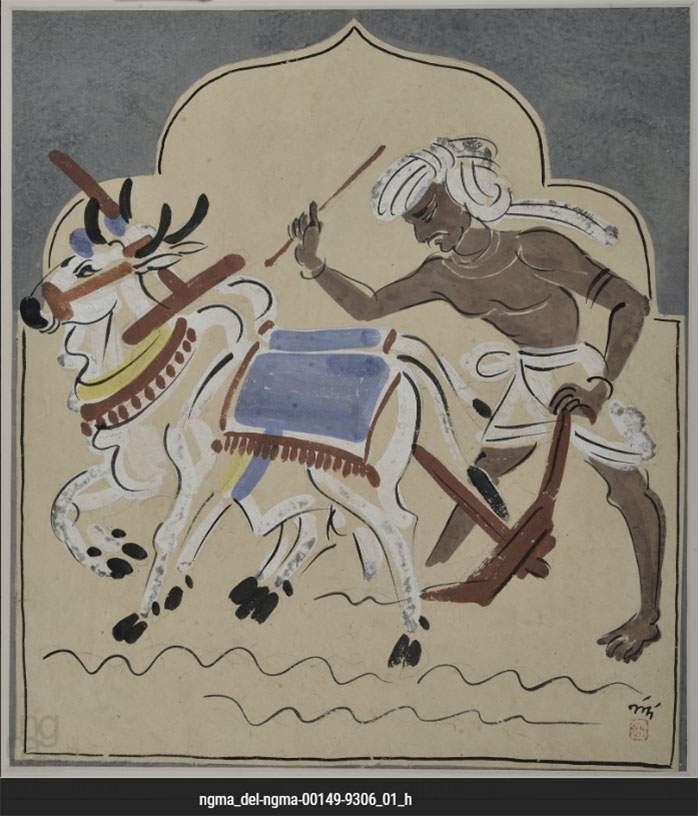
“Tiller of the soil” by Nandalal Bose 1938
(Image source)
This is a modern painting created by Nandalal Bose. In this poster, he has depicted a cow with her calf, and a woman milking a cow. This has been executed in vibrant earthy colors and spontaneous, energetic contouring lines that aptly link the figure with the artist’s sensibilities. It is created by using tempera on paper. It is signed ‘Nanda’ in Bengali in the bottom-right corner of the frame. It is exhibited in the National Gallery of Modern Art, New Delhi.
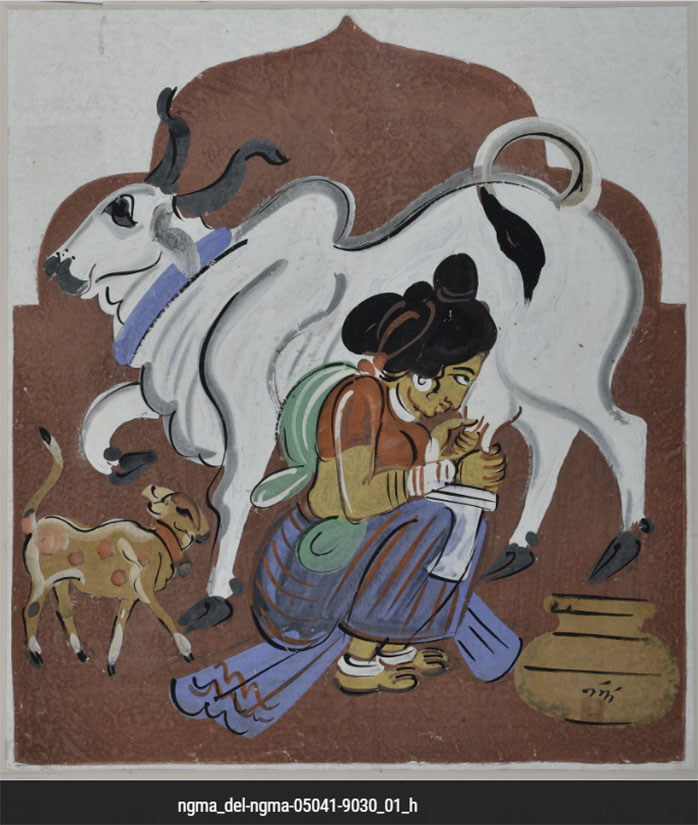
“Milking of Cow” by Nandalal Bose.
(Image source)
